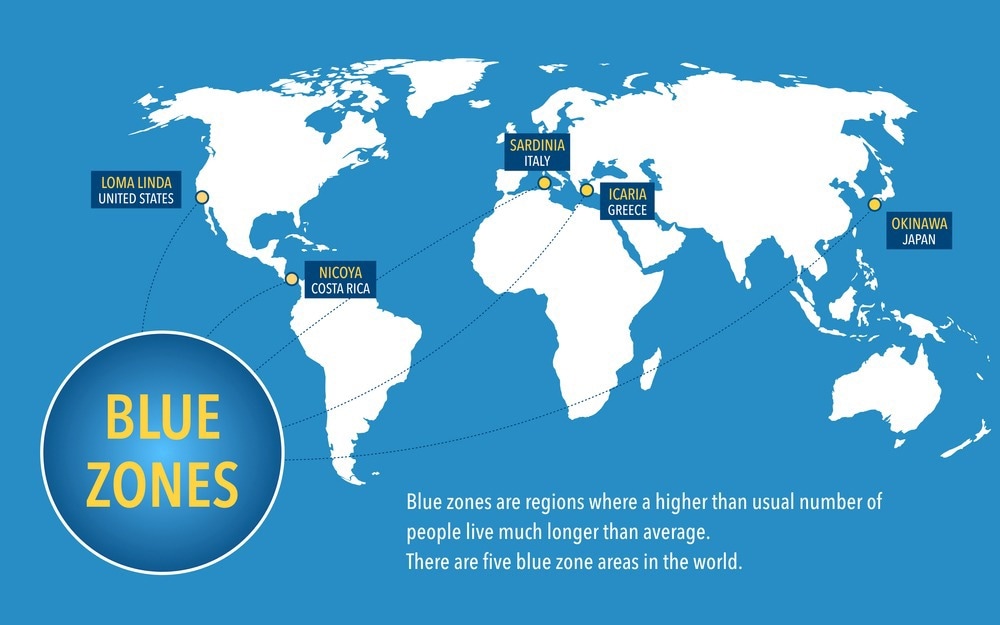Intro To Blue Zones
The term “blue zones” refers to the regions of the world that have the healthiest, longest-living people (centenarians). These regions have significantly lower prevalence of heart disease, diabetes, cancer, and obesity. In 2005, National Geographic & Dan Buettner ventured out to investigate how these zones were living and eating. Currently, there are 5 recognized blue zones:
- Okinawa, Japan
- Sardinia, Italy
- Nicoya Peninsula, Costa Rica
- Ikaria, Greece
- Loma Linda, California USA
Though these regions are thousands of miles apart from each other with different cultures, traditions, agriculture, and economies – Buettner found many similarities amongst them all that likely contribute to their success in having the greatest health on the planet.
- Plant-based diet
- Moderate calorie intake
- Low tobacco & alcohol intake
- Regular physical activity
- Strong social connections
- Manage and reduce stress

Clean, Smart Dietary Patterns
Diet plays a major role in overall health. The foods we eat have the power to nourish, build, and protect our bodies- whereas poor choices can increase the risks of developing chronic diseases or cancer. Therefore, we must choose wisely! A blue zone diet is full of foods found to have preventive and supportive health benefits. These are the main components of a blue zone diet:
- 95-100% plant-based
- Whole foods (single ingredient, raw, cooked, fermented, minimally processed), daily
- Oats, quinoa, whole wheat, brown rice, farro, millet, barley
- Tofu, sourdough bread
- Nuts, seeds, legumes
- Fruits and Vegetables
- Consume beans every day
- Snack on nuts
- Favor fish (1-3x per week)
- Limiting eggs (3-4x per week)
- Limit added sugars to no more than 7 tsp (28g) daily
- Limit meat consumption (2-5x per month)
- Beef, chicken, turkey, pork, venison, etc.
- Limit dairy consumption
- Prioritize water, coffee, and unsweet tea as beverages of choice
Blue zone diets are rich in whole foods that are minimally processed and recognizable (ie. all the ingredients are whole and visible), prioritizing the most fiber and nutritious selection! By eating this way, the gut microbiome is supported, nutrients are better absorbed by the body, and all of the extra preservatives and additives that may be harmful to health are avoided. Such foods include whole grains (oats, quinoa, rice), fermented foods (tofu, sourdough bread, sauerkraut), raw fruits & vegetables, nuts, seeds, and legumes. These regions consume beans and nuts daily, promoting benefits in lowering cholesterol, supporting digestion, and providing protein for maintaining muscle and skin strength!
Staying Physically Active
In addition to diet, physical activity is an integral and daily component of health that the longest-living people on Earth do not miss out on. Surprisingly, organized exercise is not common. Rather, physical activity is integrated into their daily lives with walking or cycling as modes of transportation to work/school/restaurants/grocery store, gardening and yard work, cooking, making their doughs, cleaning the house, etc. Movement is everywhere, every day!
Community & Socialization
Blue zones are not just characterized by physical health or centenarians. Spirituality, socialization, and a sense of community are essential qualities that each of these regions prioritize. Centenarians of these regions place heavy emphasis on their relationships with family, friends, and their faith. Staying socialized – whether it be living with others, attending church, joining a hobby group, or simply going out to the grocery shop – is very beneficial for emotional health, which translates to physical health!
Written by:
Meredith Wood
mwood20@twu.edu
